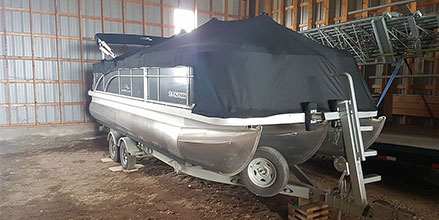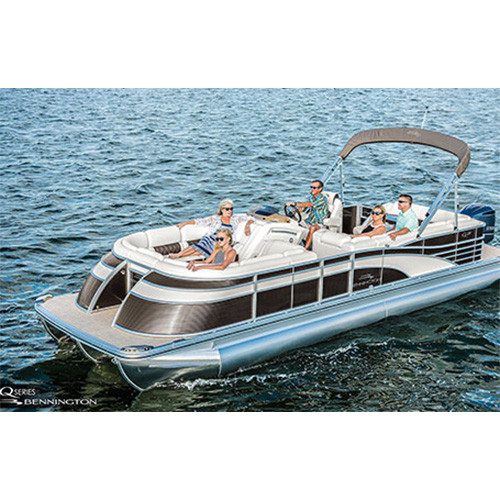
Storing Your Pontoon Boat for the Winter
Fall is always a busy time of year, especially in colder regions. There can be a lot of work to do before the snow falls and temperatures dip below freezing—chopping and stacking firewood, insulating the house, servicing your vehicles, doing yard work and getting snow tires out of storage, all while racing to beat an unpredictable start of the season.
With so much already on your plate, winterizing and storing your pontoon boat is a project that should be started as early as possible so you aren’t rushing to beat the snow. We’ve compiled this list of tips to properly get your pontoon boat prepared for winter storage so that it’s ready to hit the water as soon as warm weather returns.
Preparing the engine and Systems
Arguably the most important part of the boat, the engine requires several steps before it can lie dormant for the winter. Filling the gas tank to around three-quarters full will provide space for the gas to expand as it gets colder, and also reduces the amount of room for air condensing in the tank. Adding a fuel stabilizer will prevent the gasoline from breaking down during storage, which can plug up parts of the engine. Run your motor for a few moments after adding the stabilizer.
If you have a four-cycle motor, you’ll also need to manage the oil by turning on your engine briefly to warm it up and then replacing the oil with fresh oil. During long storage, oil will settle in the engine and can lead to damaged pistons or valves. This can be avoided by removing the spark plugs and spraying fogging oil into the spark plug holes, as well as inside the carburetor. When you replace the spark plugs, leave them disconnected. Be sure to flush your engine to clear out any water that may be inside, as this can lead to corrosion.
Outboard motors need to be cycled up and down a couple times in order to circulate the fluids. You should also leave the motor tilted down while in storage to allow all of the water to drain out of the cooling system. Otherwise, water can become trapped inside, where it can freeze and expand, cracking or damaging important engine components. Leave your motor unwrapped as well, or else you risk a build-up of condensation that can cause corrosion in the electrical system or throttle and shift linkages.
This is a great opportunity for a basic inspection and some preventative maintenance while the boat is out of the water. Replacing worn parts now will mean you have more time for fun once spring rolls around again. Take this time to make sure your pontoon boat is adhering to your state’s boating safety regulations. If your state requires that you carry specific emergency equipment, like extra personal flotation devices, a fire extinguisher or a visual distress signal, make sure you’re compliant by the time you hit the water the following year.
Charge your battery to full before storage. A discharged battery can freeze at temperatures as high as 20 F, while a fully-charged battery will be perfectly fine all the way down to -95F. Cold weather can actually help preserve your battery by slowing down the chemical reaction inside. Some prefer to remove the battery from the boat and keep it inside over the winter, while others will leave it in the boat with either a trickle charger attached or periodic check-ups during the winter to make sure the charge is topped-off.
Storage Solutions
First and foremost, your pontoon boat needs to be covered against the elements. Even if you plan on storing your boat inside, a good tight-fitting cover or seal will help keep out dust and insects. There are a few options for this, ranging from a quality waterproof canvas cover to shrink-wrapping the entire boat. There are shrink-wrap kits available for purchase if you feel comfortable doing it yourself, or you can find a local professional service to properly seal your boat for the winter. If you do it yourself, be sure to include a way to support the cover from inside so that snow or water can’t build up and collapse the cover into the boat.
A storage factor that not many boat owners think about is protection from rodents and insects. A boat can be an appealing place for critters during cold winter months, and a plastic or canvas barrier only offers temporary protection from their sharp, gnawing teeth. The same rodent and insect prevention techniques in your home—traps, poison, mothballs—also apply to your boat. While a dependable last line of defense in your boat, consider using humane methods of discouraging interest in your boat in the first place, like spraying a rodent repellant around the perimeter of your boat.
Removing all accessories that are capable of being removed can ensure that they remain damage-free and cannot be stolen. This includes any electronics, furniture, seats, ladders or tables. Cold weather can damage depth finders or audio equipment, as can condensation. Depending on where you choose to store your pontoon boat for the winter, you may want to remove the motor as well, as it can be a prime target for thieves.
A thorough cleaning should be the last thing you do before sealing your boat up and sending it off to storage. Not only will a spotless boat be a welcome sight in the spring, it will also prevent mildew from forming. A dark, sealed boat can provide perfect conditions for mildew to thrive. While your boat is out of the water, take the time to clean the exterior as well. Scrape off any scum or sediment and give it a good polish for extra protection.
By planning ahead for these tasks, you can take your time with winterizing and storing your pontoon boat and avoid the stress of hurrying to get it done before an unexpected blizzard bears down on you. When spring comes around and the lakes thaw, you’ll be happy you spent the time to fully prepare your boat so that it can go straight from storage to the water.
Photo Courtesy of Paul Clarke












